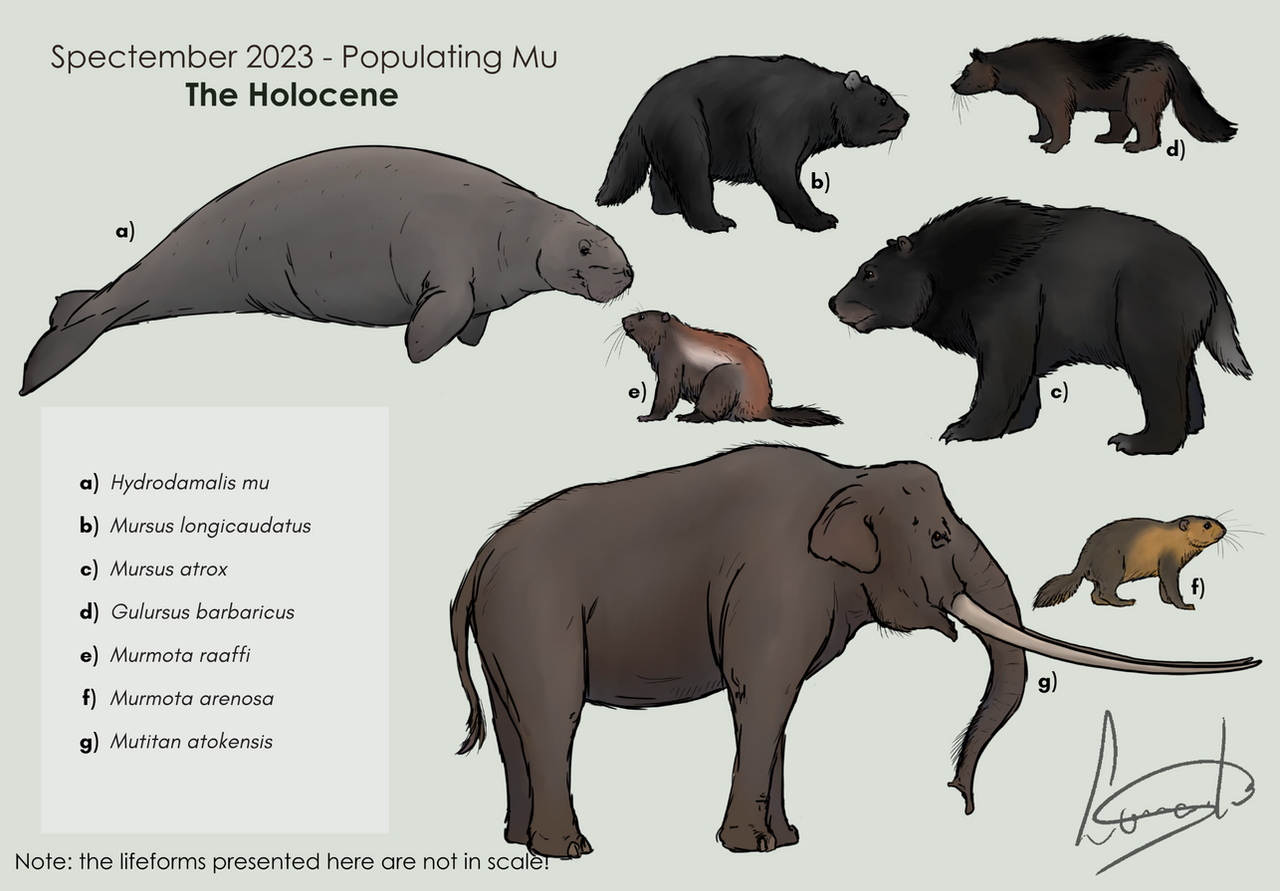HOME | DD
 leonardismos — Populating Mu - Holocene's mammals (part 1)
leonardismos — Populating Mu - Holocene's mammals (part 1)

#populatingmu #speculativeevolution #speculativebiology #spectember #speculativezoology #spectember2023
Published: 2023-10-07 18:39:25 +0000 UTC; Views: 8431; Favourites: 180; Downloads: 0
Redirect to original
Description
In this batch of muvian creatures I decided to bring only “recent” creatures, descendants of the ones that displaced and drove to extinction many native lineages, the mammals that came to the island by the Mulaskan Highway or swam to Mu during that time.
a) Lesser sea cow (Hydrodamalis mu): reaching 2,5m long and 250kg, these creatures are pretty similar to their giant cousin, the Steller’s sea cow. With muscular lips, this sea cow feeds on algae and aquatic plants all around muvian waters, with some populations even going inland through large rivers.
Lesser sea cows live in small loose groups and sometimes can congregate in large herds when food is available. Females give birth to a single calf and the whole herd helps the raising and protecting. Among the predators of this sea cow are the sharks, crocodiles and maned bears, which can drag smaller individuals out of the water.
- The lesser sea cow is a descendant of a creature that swam to muvian waters during the time of the Mulaskan Faunal Highway, but wasn’t doccumented;
b) Long tailed bear (Mursus longicaudatus): a mostly nocturnal ursid, the long tailed bear is a solitary omnivore found in mountainous forested areas and woodlands. Reaching 1,7m long and 130kg, these creatures are usually calm and tolerant with other fauna.
With a short head and powerful jaws, the long tailed bear have a preference for roots and stems than meat but can easily stalk and subjugate creatures heavier than it. Females give birth to up to three cubs, which stick to their mother until becoming independent. Differently from other large ursids, long tailed bears do not hibernate.
- The long tailed bear is one of the direct descendants of Another_leo’s (Leonardismos) grey bear;
c) Maned bear (Mursus atrox): omnivores with a preference for meat, these ursids are one of the biggest terrestrial predators of Mu, reaching 500kg and 1,4m tall on shoulder. Maned bears are powerful hunters, able to bring down large prey with the aid of the strong forelegs, sharp claws and large and jaws.
Lone creatures found in the northern portions of Mu with small populations in the south, maned bears can be seen congregating in situations of abundance of food. Females give birth to up to four cubs, which are raised until being able to handle themselves. Differently from other large ursids, maned bears do not hibernate.
- The maned bear is one of the direct descendants of Another_leo’s (Leonardismos) grey bear;
d) Mudger (Gulursus barbaricus): a surviving lineage of basal ursid, the tree mubear is a versatile omnivore found in most of muvian terrestrial ecosystems. Opportunistic and adaptable, this creature feeds on leaves, sprouts, seeds, fruits, nuts, roots, fungi, small animals, eggs, carrion and even aquatic creatures since they are also good swimmers.
Mudgers are usually solitary creatures, but sometimes can be seen in pairs. Females give birth to one or two cubs, which are fiercely protected by the mother until becoming independent. These primitive bears can reach 1,3m long and weight 25kg.
- The mudger is one of the direct descendants of Another_leo’s (Leonardismos) black forest bear;
e) Mountain murmot (Murmota raaffi): reaching 75cm long and 6kg, this sciurid is one of the biggest rodents of Mu. Mainly herbivores, with a rare occasion of insect eating, the mountain marmots live in small social groups in the northeastern and central Mu’s mountains.
- The mountain murmot is one of the direct descendants of Another_leo’s (Leonardismos) black tailed sciurid;
f) Ground murmot (Murmota arenosa): found in the dry semi-arids of Mu, this sciurid is a social creature that lives in complex systems of burrows. Reaching 40cm long, the ground murmot feeds mainly on grasses, seeds and roots but also can eat small insects and rarely carrion.
- The ground murmot is one of the direct descendants of Another_leo’s (Leonardismos) black tailed sciurid;
g) Hairy trunked mastodon (Mutitan atokensis): found in temperate woodlands, grasslands and swamps of Mu, this mammutid is one of the heaviest creatures found in Holocene’s Mu reaching an average of 3 tons (males) and 2 tons the females.
Gregarious herbivores, these mastodons are often seen in small social groups of females browsing peacefully. Males are often solitary or live in loose bachelor groups. Adults have no predators while infants and juveniles can be preyed upon by carnivores and crocodiles.
Both males and females have long tusks when adult, with the male’s being slightly bigger than females. Mature individuals also present an unusual amount of long hair near the tip of the trunk, the function of this structure seems to be social, since is common to see individuals “combing” each other with this part of the trunk.
- The hairy trunked mastodon is one of the direct descendants of u/Atok_01’s muvian mastodon;
SailWorldbuilds
Related content
Comments: 9

👍: 0 ⏩: 0

👍: 0 ⏩: 0

👍: 0 ⏩: 0

👍: 1 ⏩: 1

👍: 0 ⏩: 1

👍: 0 ⏩: 0

👍: 1 ⏩: 1

👍: 0 ⏩: 1

👍: 1 ⏩: 0
























